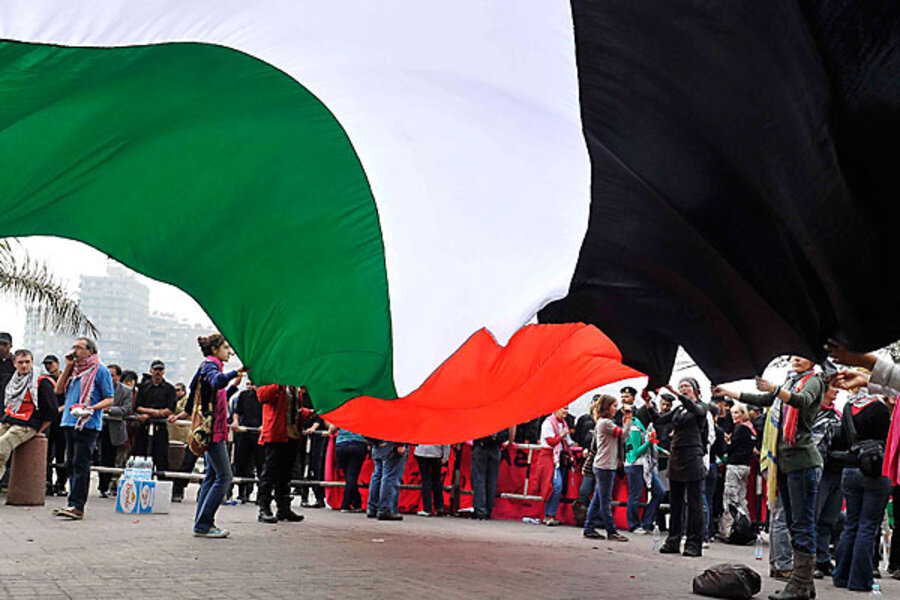Gaza war anniversary: How one group helps victims overcome trauma
Loading...
| Jerusalem
Rawya Hamam was watching her son deteriorate. Hisham wouldn't sleep, clung to her incessantly, and said he wanted to go back into her belly so he'd be safe. "Grandma is lucky she died so she doesn't have to live here now," the boy told his mother.
It's not a normal statement to expect from a five-year-old child, but neither were these normal times. A year ago, at the outbreak of war between the militant Palestinian group Hamas and Israel, anything resembling a normal life disappeared into a violent maelstrom that wreaked unprecedented destruction on the Gaza Strip. More than 1,400 Gazans were killed, according to a Palestinian count, in a campaign the Israeli army named "Operation Cast Lead," with the aim of getting Hamas to stop the daily launch of occasionally fatal rockets onto Israeli communities. Thirteen Israelis were killed in the three-week war.
The sad aftermath of the war is still being calculated; the possibility of war crimes having been committed by either side is still being debated. Thousands of homes destroyed in the war have not been rebuilt, and many public buildings lie in ruins for lack of steel and cement to fix them.
But what remains more immediate for many Gazans is dealing with the unspoken internal damage – the effect on the population's mental health. Estimates from several organizations hold that between 30 and 40 percent of the Gaza population is suffering from signs of PTSD – Post Traumatic Stress Disorder. A study by the Gaza Community Mental Health Programme in June found that two-thirds of Gaza's children have exhibited abnormal levels of anxiety, and 61.5 percent of Gaza's parents reported the emergence of unusual behaviors among their children.
Ms. Hamam considers herself one of the fortunate ones, in that she's recently been trained in the use of new tools to help others she works with professionally – as well as her own children. Last week, she completed a second, advanced training program in Gaza that is part of the Healing the Wounds of War (HWW) program, launched by the Center for Mind-Body Medicine, based in Washington.
Using alternative, nonmedical techniques to discharge pent-up stress and trauma, the center has, for more than a decade, been bringing its work to global war zones and disaster areas. Its postwar program began in Kosovo, where its work helped reduce children's diagnosed levels of PTSD symptoms from 88 percent to 38 percent, founder Jim Gordon says.
"What's different about this is that it's not a pathological model - it's for people who want to learn to take care of themselves," Dr. Gordon explains in a Jerusalem interview following a recent week-long training session Gaza, his 16th visit to the embattled coastal strip since 2002. Domestically, the center helped victims of Hurricane Katrina, and more recently, the center has been helping US soldiers returning from Iraq and Afghanistan. Rates of postwar psychological disorders have become an increasing priority for the US military, following the massacre at the Fort Hood military base in Texas last month.
"We have many people come who would never dream of seeing a therapist, but will come to a group to share their experiences," Gordon says. "We teach them in a large-group setting to use these techniques to quiet themselves and to mobilize their imagination."
That, says Hamam, a nurse, was particularly helpful at home. Hamam would help Hisham and his two older siblings use "guided imagery" to put themselves mentally in a "safe place," and used forms of expression like drawing and movement to get them to work out what they're experiencing and remembering.
"When people have flashbacks of the war, their bodies became more tense, to the point where they can make their body feel as if it's experiencing the trauma again," Hamam says. "We ask them in their imagination to find a place where they feel calm, though some people here, adults and children, have a hard time even imagining a safe place."
Ramadan el-Helou, one of about 40 Gaza trainers involved in the program – who, in turn, train other health professionals, social workers, and teachers – says sometimes it's hardest on the people who, like him, are supposed to be helping others, and are therefore exposed to the war's residue day in and day out. And yet, he treats his own story as almost typical.
He describes days when his neighborhood along the Gaza beachfront was getting hit by Israeli artillery from land and sea. He had to move his family of five twice, each time trying to escape the epicenter of the conflict. By the time the three weeks were up, he'd lost six relatives.
The skills he learned in dealing with the pressure helped him and his family cope, he says. And a year later, some of these techniques are being used in schools.
Jamil Atti, the Gaza program director, has worked with families in some of the most devastated areas, such as Ezbt Abed Rabbo, and with families who have lost multiple members. Most other postwar social activities, he says, just focus on getting kids to a recreation hall to have some fun.
But ignoring the problems, he says, isn't helpful for long. "We're teaching people how to be aware of their emotions and feelings, and try to clarify connections between body and mind. Step by step, we teach people how to relax," he says. "And the need for that is huge."





